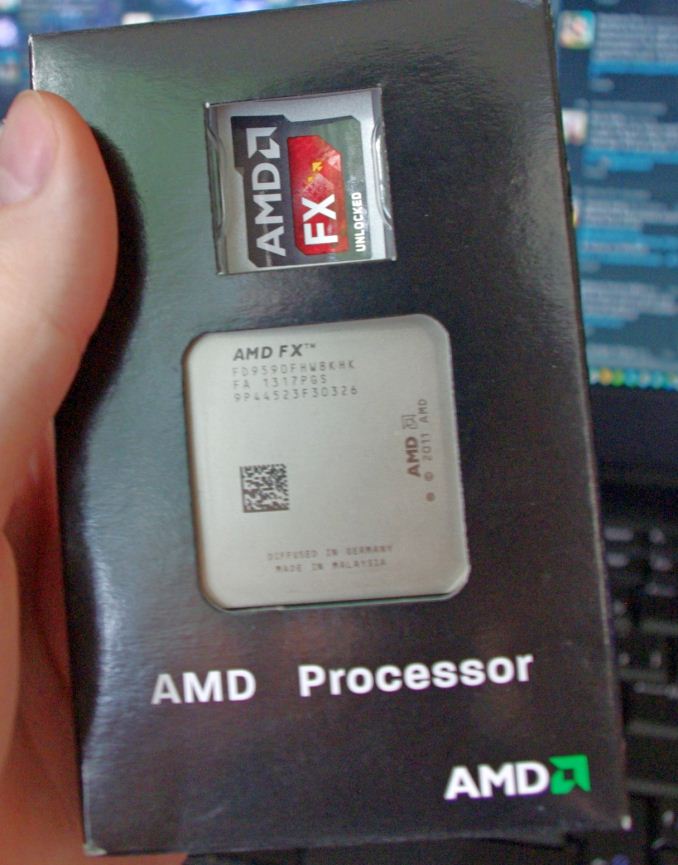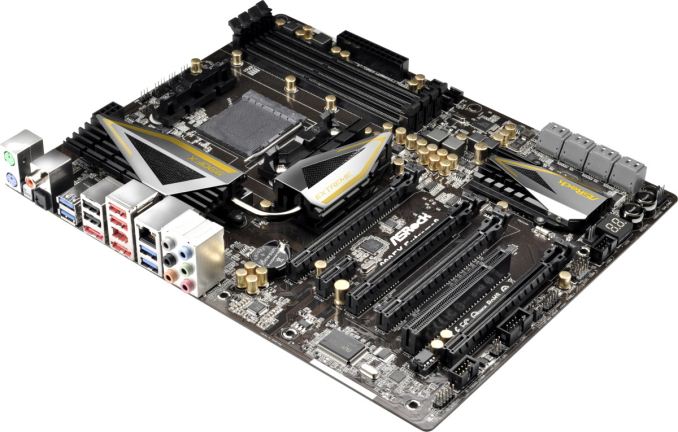AMD’s 5 GHz Turbo CPU in Retail: The FX-9590 and ASRock 990FX Extreme9 Review
by Ian Cutress on August 9, 2014 8:00 AM ESTThe AMD FX-9590
The analysis in this review shows that even a year after the OEM release of the FX-9590, and almost two years from the architecture coming to market it remains AMD’s performance part. If power consumption is not a concern, as a CPU compute and an AMD gaming CPU (especially when considering SLI) the FX-9590 is the best choice at stock speeds. On that basis alone, it makes sense that AMD should actually release it as a retail part, assuming they have enough stock. One might argue that a user could buy an FX-8350 and overclock, but if our sample CPUs were anything to go by, a user needs a fair bit of luck. The FX-9590 guarantees a 5.0 GHz turbo with a warranty.
With the retail release of the CPU, that warranty might be based on using the water cooling provided for the lifetime of the CPU. One might argue that AMD had trouble finding enough dies that could reach the frequencies and voltages for the FX-9590, and hence the delay combined with selling the SKU in select markets only.
The FX-9590 is the same Piledriver architecture as the FX-8350, which in turn was used in the A10-5800K/A10-6800K APUs, codename ‘Trinity’ and ‘Richland’ respectively. Since then, AMD has launched the Steamroller architecture modifications in the form of Kaveri APUs. The difference between a PIledriver APU and a similar frequency Steamroller APU, if we put aside the move from 32nm SOI to 28nm SHP, is around 10% for CPU performance. If that was shifted into a four-module, eight-thread CPU, it would surely be AMD’s performance part. The issue here is that AMD has almost discarded the high CPU performance arena in favor of integrated graphics. From Trinity to Kaveri, the IGP inside those APUs has improved considerably, indicating where AMD is investing its research dollars.
AMD clearly still cares about the performance market, otherwise this retail FX-9590 with water cooling would have never been pushed through to retailers. The high power consumption, the lack of a modern chipset, and the comparison to Intel CPUs in single threaded benchmarks are the main barriers to adoption. If AMD is to return to the performance market, the power consumption has to be comparable to Intel, or if it is slightly higher, the chipset has to offer something Intel cannot. Any suggestions for what that feature should be should be submitted on a postcard/in the comments.
ASRock 990FX Extreme9 Conclusion
One of the big issues surrounding AMD motherboards is their price sensitive nature. With an Intel based product, a $250-$400 motherboard is common enough to signify the expense in research or extra features. Because the AMD ecosystem, even in the high performance segment, is a cost sensitive market there is little room to move. For example, this year sees the first overclocking based motherboard for AMD APUs since the AM3+ era. So at $170, the Extreme9 could arguably be described as ‘limited’ compared to Intel standards.
The motherboard itself has specified support for 220W CPUs, something other motherboards either fail to mention or advise against completely. The native SATA 6 Gbps ports were ahead of Intel at the time, plus ASRock adds in another SATA 6 Gbps controller for good measure.
The eight USB 3.0 ports makes the Extreme9 have more USB 3.0 ports than almost every other 990FX/AM3+ motherboard ever released. This is combined with plenty of legacy support, such as separate PS/2 connectors, a PCI slot, an IEEE1394 port and an IEEE1394 header. The Intel NIC is paired with a Realtek ALC898 codec, with the PCIe layout aimed at 3-way GPU users for both Crossfire and SLI.
Aside from an updated chipset, if we were building a high-end AM3+ motherboard in 2014, I would insist on WiFi support and an upgraded audio codec to the ALC1150 at the minimum. We cannot get around the lack of PCIe 3.0 support, although moving the CPU modules from Piledriver to Steamroller along with the IO support might help with that. If we are being greedy with what we would like, I would add in M.2 support as well.
There is plenty to speculate if AMD had kept updating their high-end performance CPU line, even if the socket was not updated. As it stands, users who want SLI either look back to 990FX or invest in Intel. Users who want high multithreaded CPU performance either look back to 990FX or invest in Intel. Users who do not want processor graphics either look back to 990FX, buy an APU with the graphics disabled, or invest in Intel. AMD clearly does care about the performance market, or at least someone senior in the company does.












146 Comments
View All Comments
just4U - Sunday, August 10, 2014 - link
In my opinion the best cpu AMD has right now is A8 7600 coming in at $120 CAD. I see no reason to go Intel i3 as long as that puppy is there. (A argument can be made for Intel's AE 3x) The downside for AMD is I also see no reason why anyone should buy a more expensive CPU/APU from them.. their A-10 is priced in the same range as lower I5's which is a bit of a head shaker and their AM3+ is getting long in the tooth with no refresh.I could see a new FM2+ FX branded cpu priced at the tier their offering their A-10s for as it would bring something more to the table.. but they do really have to do something about single threaded performance. Even if it wasn't being used as much in programs their line-up takes a beating in reviews which is bad optics for them and leads to people like us (who read these things..) to suggest other alternatives for people buying/building a system.
FightApathy - Sunday, August 10, 2014 - link
237W operational power consumption. This is just.... terrible for a 2014 CPU. And what is even worse, is that i7 with 1/3 of TDP performs as well or even better. AMD has to stick to APUs.KAlmquist - Sunday, August 10, 2014 - link
"One could speculate that releasing the next generation of FX-85xx might put them behind the FX-9590 in performance, or that the fabrication process was not suitable for a quad-module CPU with the new architecture improvements."According to the Steamroller review, the 28nm bulk process that Steamroller was designed for won't clock as high as the 32nm SOI process that Piledriver uses. So an 8 core Steamroller processor would execute more instructions per clock, but would be clocked at least 400 Mhz slower, and as a result would be only marginally faster than Piledriver.
AMD is expecting to achieve another boost in instructions per clock with Excavator, but unless something has changed they plan to synthesize Excavator using software that minimizes die area at the cost of clock speed, so I'd expect Excavator to do more to improve performance per watt than to improve absolute performance.
After Excavator comes a completely new design, which we can hope will be a major improvement over the bulldozer derivatives.
mathewmichal7 - Sunday, August 10, 2014 - link
Draft your credit agreement is an excellent example of an innovative style of marketing. There is a provision for the lender to get cash advance check their debtors. He takes comfort in check on the day of your salary. Undoubtedly reduces the possibility of non-payment money and is beneficial for the creditor and the debtor. Delinquent and insolvent are not left disappointed by the money lenders. Your loan application forms become a matter of serious consideration if they manage to impress your money lenders for their current financial situation. The number of your credit profile does not control the situation and creditor left unchecked.http://www.12monthloansmoney.co.uk
duploxxx - Monday, August 11, 2014 - link
funny to read all these replies. makes you wonder what avarage age and technology knowledge is of these tech sites.....All complaining about useless AMD and process tech but yet they don't understand that these own consumers are the ones to blame, they buy the jingle and bells and the marketing buzz... recent review on anandtech showed enough what was best to buy, yet most decide to buy the other marketing dominant brand as if there all day tasks are faster since the benchmarks show few percentage faster finished task... buyers need to blame themselve for there own stupid decisions. Want a fast system? get rid of Microsoft garbage. OEM-marketing kill the competition and consumers are the victim but they still dont understand it. (useless chipset revisions, socket changes, design rules like in ultrabook space and centrino, etc, etc..). poor consumers.
From a tech site you indeed need to review such a CPU, its mandatory but i don't think it gets the honor for what it supposed to be, anyhow there will be only few to sell since it has no reason to exist becide the mythical part.
I remember the days of pentium D and extreme, no reason at all to exist yet 1000's of buyers just for the brand....
duploxxx - Monday, August 11, 2014 - link
since no edit button :) thx anandtech asking that already for more then 10yI meant age and knowledge of the readers of course
Klimax - Monday, August 11, 2014 - link
Lovely nonsensical post. Including out of date bashing of Microsoft. 90s called, they want your nonsense back.Mugur - Monday, August 11, 2014 - link
There is still room for AMD in my home. I have 2 SB Core i3s for the gaming machines and I've just replaced an 80W Phenom II HTPC with an Intel NUC 2820. But my server (currently an Athlon II X4) will be soon an A10-7800 at 45W on a FM2+ with 8 SATA board...jgarcows - Monday, August 11, 2014 - link
How did you manage to post a review of a chip with a bundled retail liquid cooling system and not post a single picture of the liquid cooling system? How easy was it to install, what size openings are needed on the case, etc...LemmingOverlord - Monday, August 11, 2014 - link
May I suggest:a) some impressions on the liquid cooling? (+pics)
b) underclocking the CPU (and lowering voltage), then map that to power v. performance curves for the same set of benchmarks you ran... just to see how big a drop it would be in wattage.